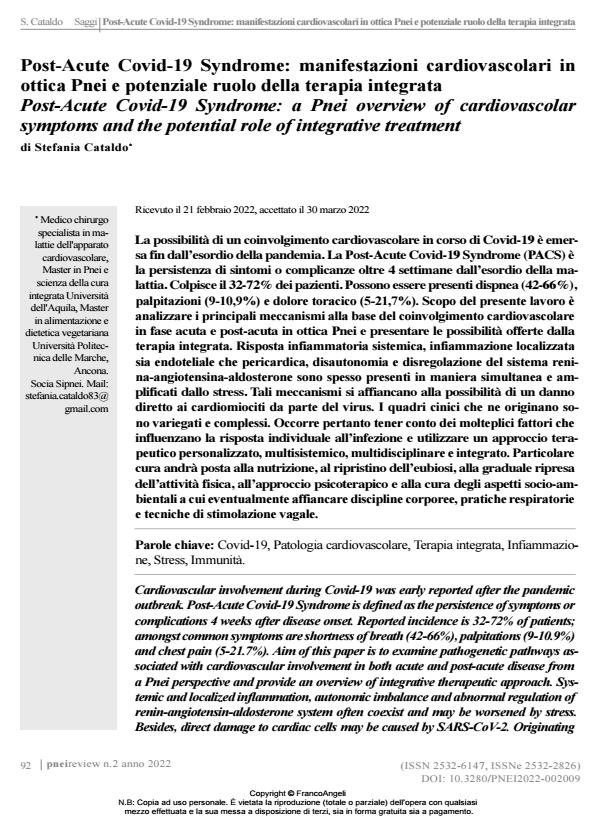Post-Acute Covid-19 Syndrome: manifestazioni cardiovascolari in ottica Pnei e potenziale ruolo della terapia integrata
Titolo Rivista PNEI REVIEW
Autori/Curatori Stefania Cataldo
Anno di pubblicazione 2022 Fascicolo 2022/2
Lingua Italiano Numero pagine 16 P. 92-107 Dimensione file 138 KB
DOI 10.3280/PNEI2022-002009
Il DOI è il codice a barre della proprietà intellettuale: per saperne di più
clicca qui
Qui sotto puoi vedere in anteprima la prima pagina di questo articolo.
Se questo articolo ti interessa, lo puoi acquistare (e scaricare in formato pdf) seguendo le facili indicazioni per acquistare il download credit. Acquista Download Credits per scaricare questo Articolo in formato PDF

FrancoAngeli è membro della Publishers International Linking Association, Inc (PILA)associazione indipendente e non profit per facilitare (attraverso i servizi tecnologici implementati da CrossRef.org) l’accesso degli studiosi ai contenuti digitali nelle pubblicazioni professionali e scientifiche
La possibilità di un coinvolgimento cardiovascolare in corso di Covid-19 è emersa fin dall’esordio della pandemia. La Post-Acute Covid-19 Syndrome (PACS) è la persistenza di sintomi o complicanze oltre 4 settimane dall’esordio della malattia. Colpisce il 32-72% dei pazienti. Possono essere presenti dispnea (42-66%), palpitazioni (9-10,9%) e dolore toracico (5-21,7%). Scopo del presente lavoro è analizzare i principali meccanismi alla base del coinvolgimento cardiovascolare in fase acuta e post-acuta in ottica Pnei e presentare le possibilità offerte dalla terapia integrata. Risposta infiammatoria sistemica, infiammazione localizzata sia endoteliale che pericardica, disautonomia e disregolazione del sistema renina-angiotensina-aldosterone sono spesso presenti in maniera simultanea e amplificati dallo stress. Tali meccanismi si affiancano alla possibilità di un danno diretto ai cardiomiociti da parte del virus. I quadri cinici che ne originano sono variegati e complessi. Occorre pertanto tener conto dei molteplici fattori che influenzano la risposta individuale all’infezione e utilizzare un approccio terapeutico personalizzato, multisistemico, multidisciplinare e integrato. Particolare cura andrà posta alla nutrizione, al ripristino dell’eubiosi, alla graduale ripresa dell’attività fisica, all’approccio psicoterapico e alla cura degli aspetti socio-ambientali a cui eventualmente affiancare discipline corporee, pratiche respiratorie e tecniche di stimolazione vagale.
Parole chiave:Covid-19, Patologia cardiovascolare, Terapia integrata, Infiammazio- ne, Stress, Immunità
Stefania Cataldo, Post-Acute Covid-19 Syndrome: manifestazioni cardiovascolari in ottica Pnei e potenziale ruolo della terapia integrata in "PNEI REVIEW" 2/2022, pp 92-107, DOI: 10.3280/PNEI2022-002009